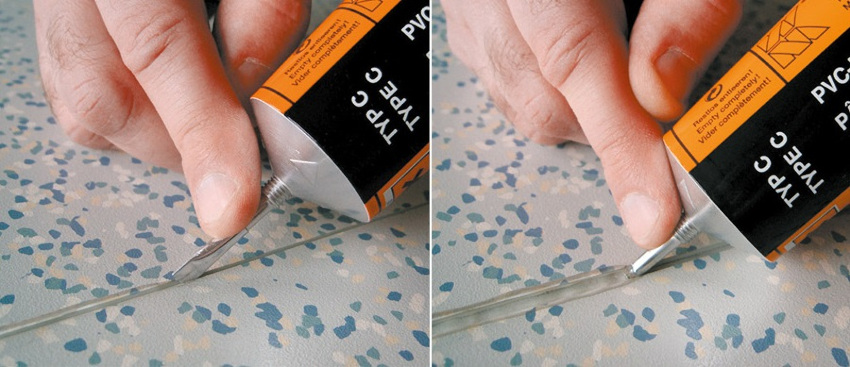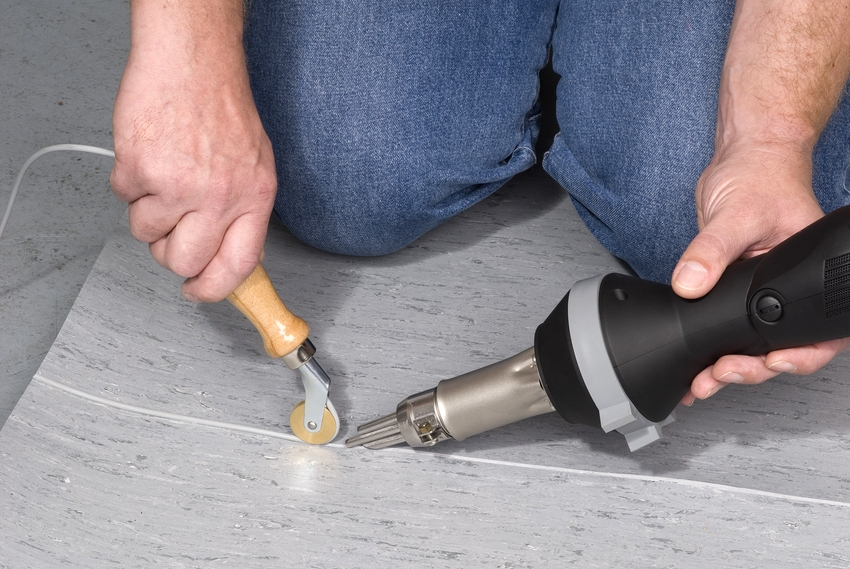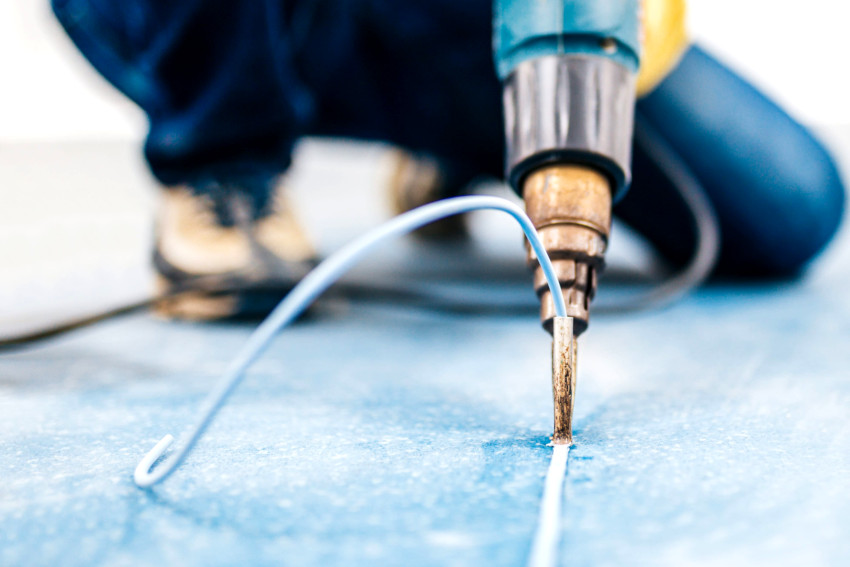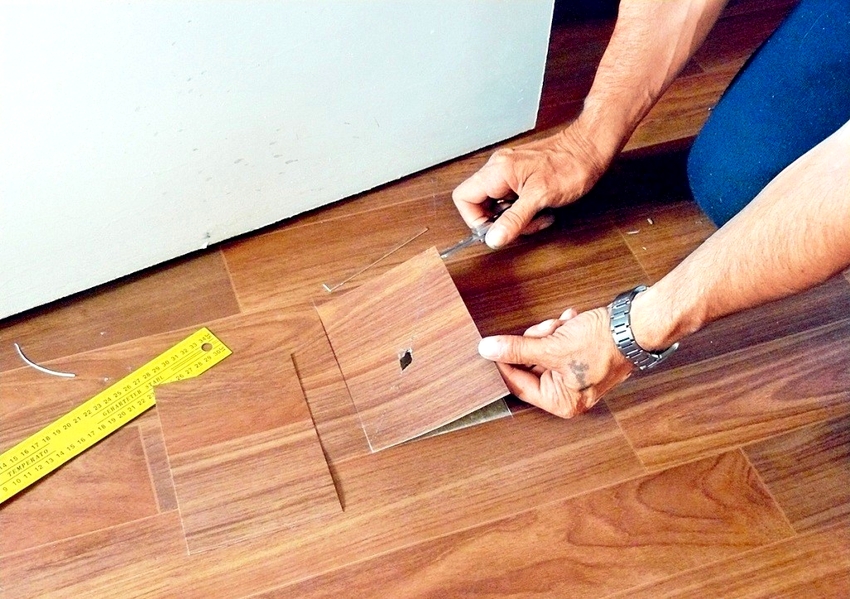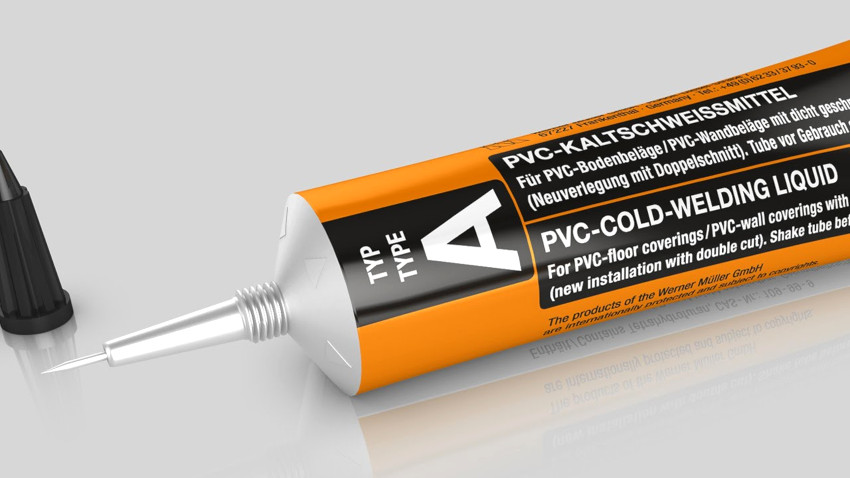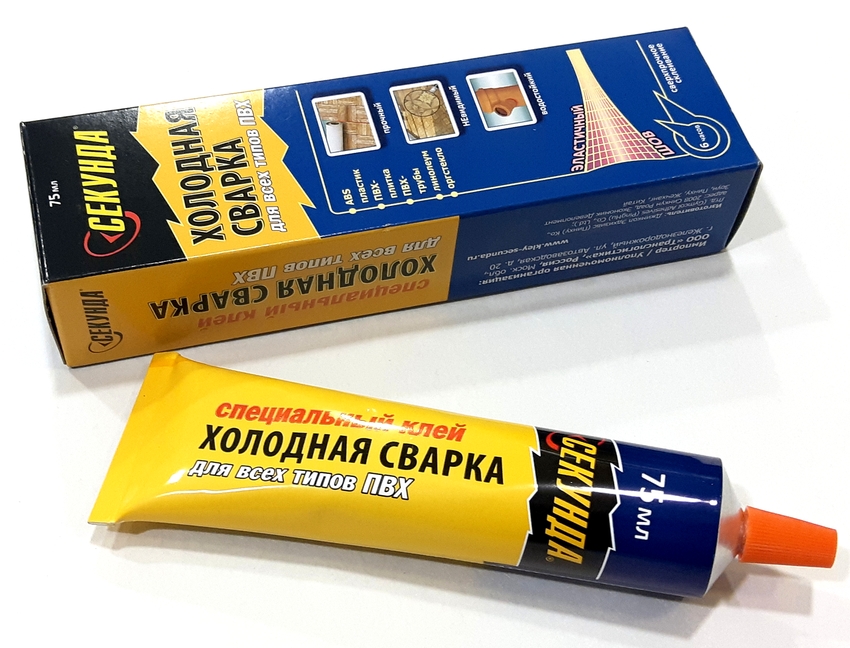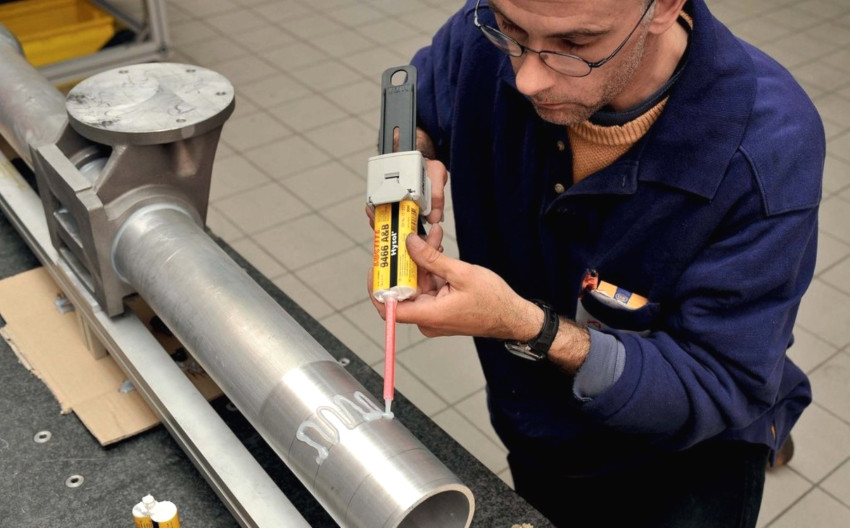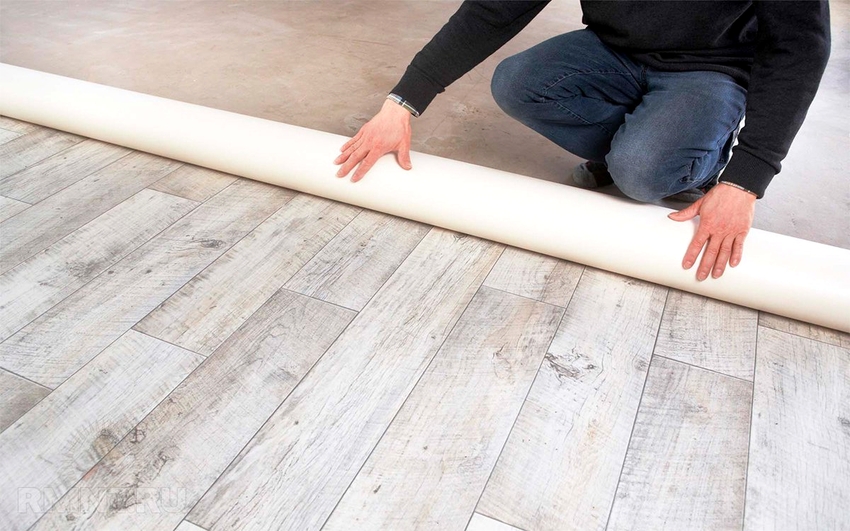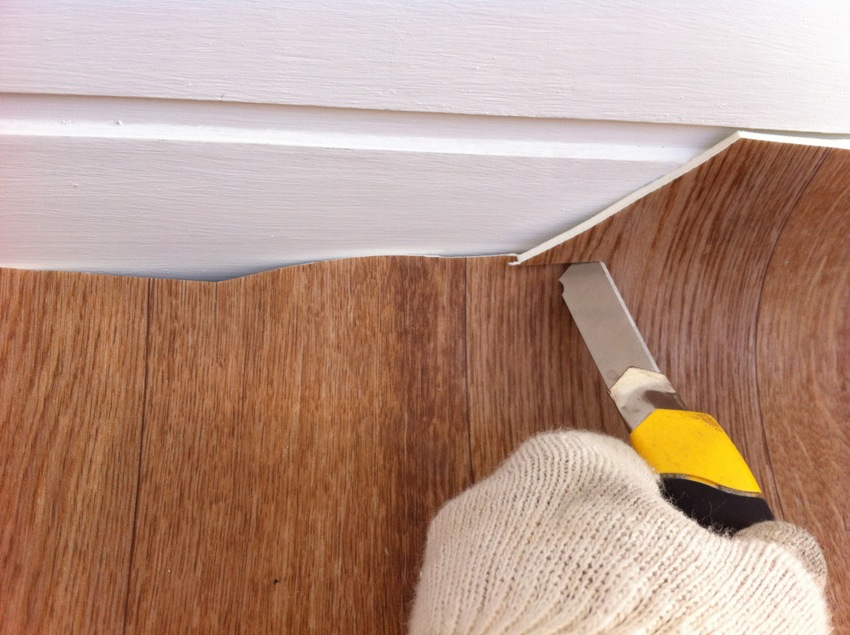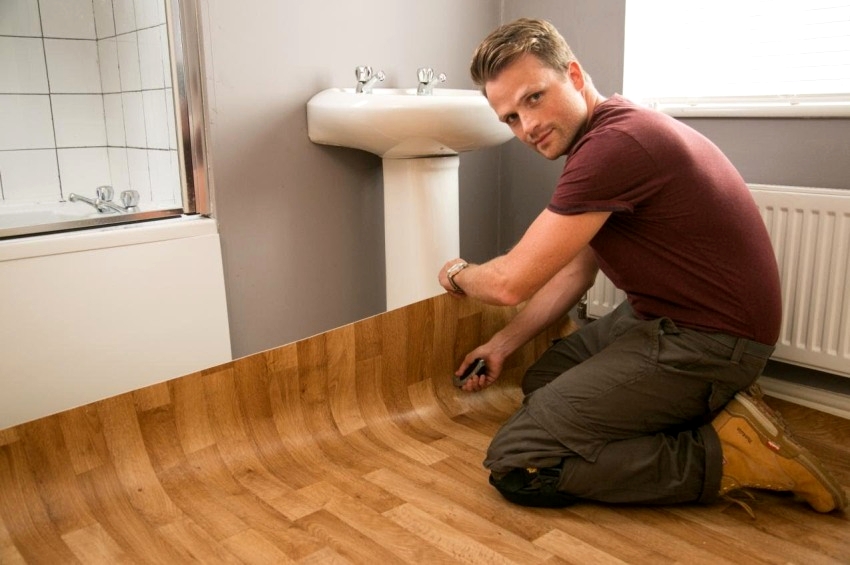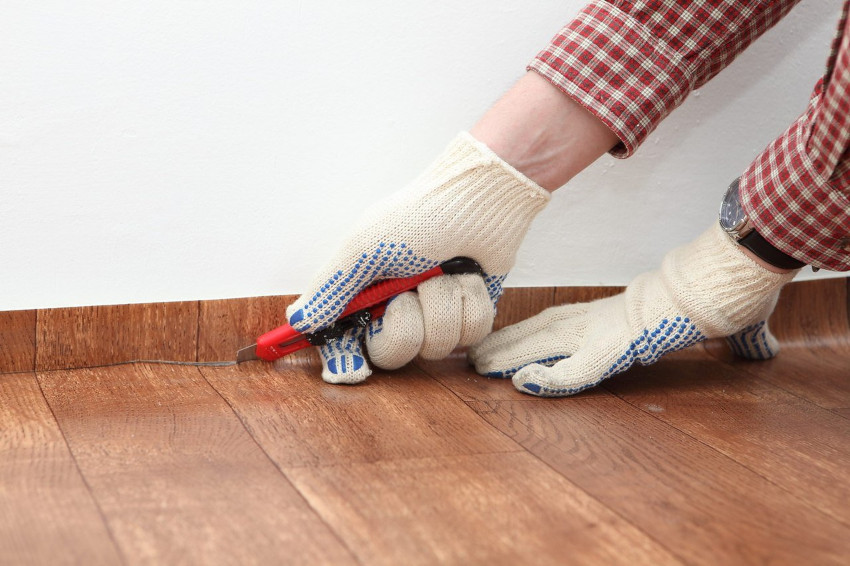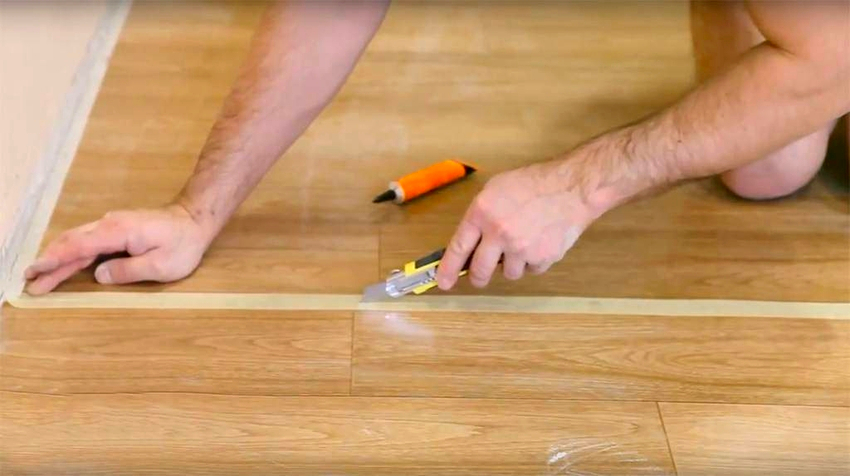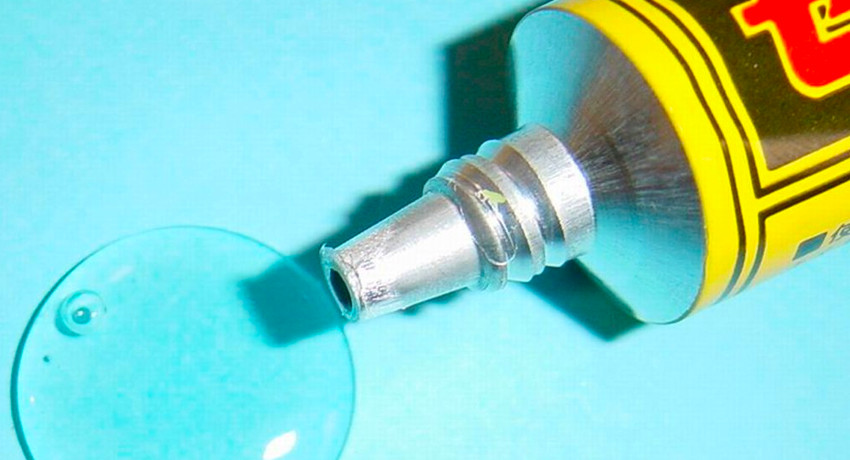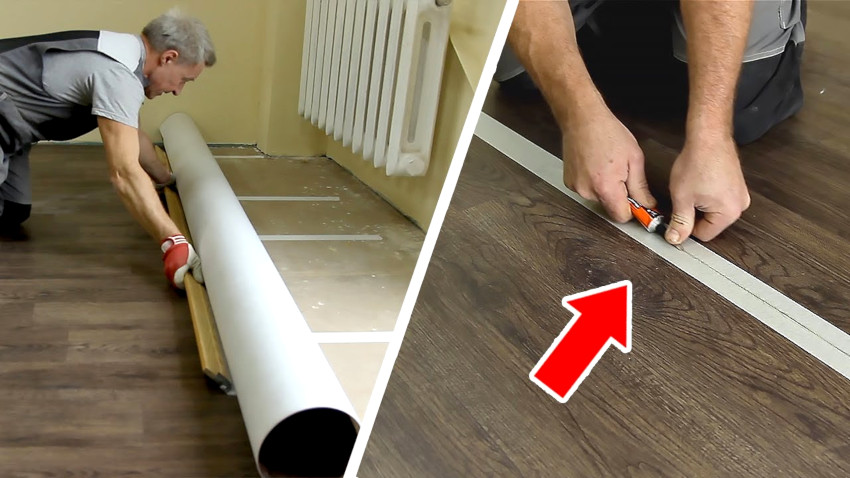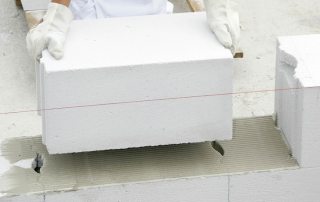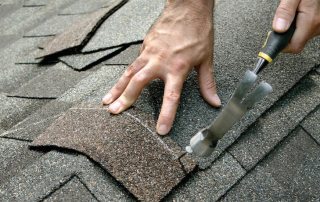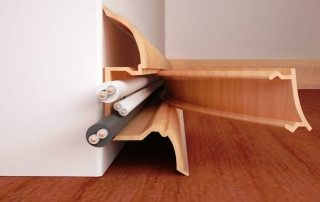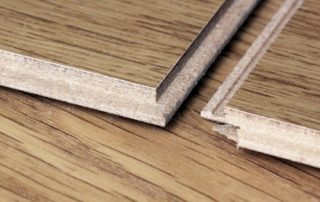Cold welding for linoleum allows you to quickly and accurately join parts of the flooring. This method of soldering the material is so simple that it is not difficult to use it even at home. From this article you can find out what tools are used to combine linoleum, plastic and aluminum. The text provides a complete overview of the characteristics, advantages and disadvantages of cold welding, as well as guidance on its use.
Content
How to glue linoleum together: material soldering methods
Linoleum is one of the most popular flooring materials. It has both advantages and disadvantages. A significant disadvantage of this material is the presence of seams. They are formed when linoleum joins between adjacent rooms, as well as when it is required to cover a large area. On the other hand, modern soldering methods allow you to easily and quickly cope with this problem without using metal sills to mask the seams.
Before delving into information on how to connect linoleum with each other, it is worth studying the properties and features of this material. This type of flooring is used as a decoration in office, residential and industrial premises. The material is easy to install, durable and waterproof, non-slip and low maintenance. In addition, there is a huge selection of colors and textures on sale. Buyers can even purchase insulated flooring options.
The advantages of linoleum also include its size. The material is produced in the form of rolls of various widths. Thanks to this, the buyer can choose the optimal size of linoleum for each room in his home. If you need to lay the material in all rooms, then you will not be able to do without cuts.Moreover, it is not always appropriate to close the joints of linoleum with metal sills or fix the edges of the material with studs. The best option in this case would be the hot or cold soldering of the sheets.
Note! Bonding linoleum with adhesive for cold welding or hot bonding of sheets are ideal for rooms with high traffic, as well as rooms where the flooring is subjected to constant mechanical stress.
Advantages and disadvantages of hot welding linoleum
The connection of linoleum sheets by hot welding is carried out due to temperature exposure. This method is most often used in industrial premises where floors are exposed to severe mechanical stress. The method is also recommended for soldering linoleum in rooms with high traffic, where the coating wears out quickly. It is advisable to use the processing of seams with a hot method when it is required to connect long joints.
How to cook linoleum with a hot method?
- For work, a special burner is used, which is called a hot air gun. This tool allows you to melt the material by heating to 400 ° C.
- Before joining linoleum, you need to prepare the joint area. For this, a part of the material along the entire length of the seam is selected with a chisel so that a groove is obtained.
- The welding cord is fed into the torch and the device is connected to the mains.
- To glue the cuts, you need to place the heated filler cord in the groove. This material has almost the same structure as linoleum. The cord is applied with slight pressure; all actions must be accurate and very precise.
- With special scissors, the blades of which are in the shape of a crescent, you need to remove excess glue before it hardens. The cuts are done carefully so that they don't get too deep.
- After the molten cord has cooled, a secure connection is formed.
- The scar in the joint area must be carefully cleaned.
Advantages of hot gluing linoleum:
- strong connection;
- absolutely tight seam;
- reliable and durable result.
The disadvantages of the hot method include some limitations in its use. This welding option is not suitable for all types of linoleum. It is designed for joining rigid and dense fabrics. The hot method is not suitable for gluing soft linoleum. Under the influence of high temperature, the material will melt, so the joint will be damaged. The same goes for low quality budget types of coverage.
In addition, hot welding requires certain skills. Not knowing how to properly glue linoleum using this technology, it is very easy to make a mistake and ruin the coating.
Note! Sometimes craftsmen use a powerful electric soldering iron instead of a torch. This option is suitable as an alternative, but it will not work to achieve a perfectly even seam with it.
Cold welding for linoleum: the pros and cons of technology
The instructions for the use of cold welding convinces that this method is much easier than the technology of hot gluing the material. No special skills or knowledge is required for work, and there is no need to purchase special equipment. This method is suitable for home renovations.
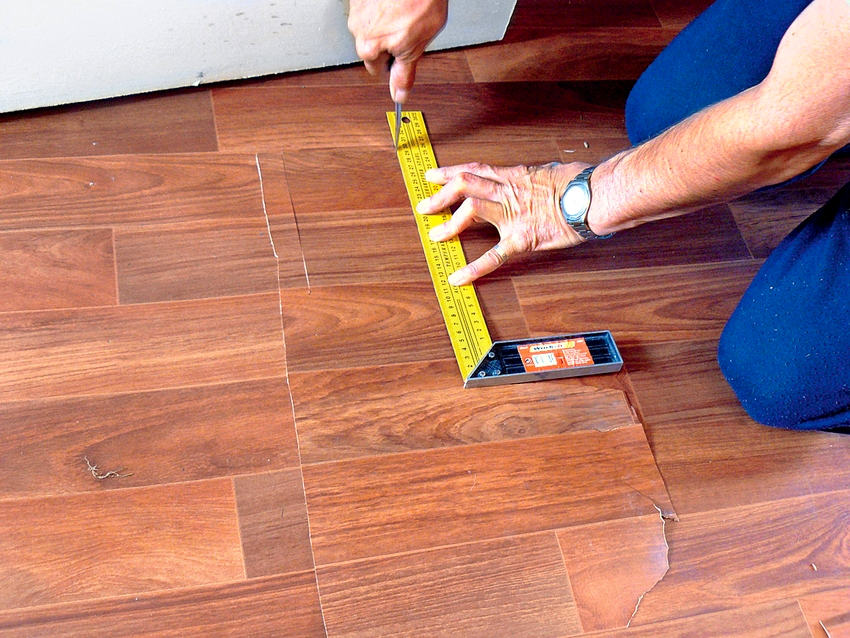
The cold welding method is much simpler and more affordable, but it needs a smooth trimming of the joints
A special adhesive is used for welding, which acts as a solvent. It softens and fuses the edges of the canvases. After the glue dries, a solid monolithic coating is formed. The seam is so thin and neat that it is difficult to notice if you do not look closely.
Cold welding has many advantages:
- the result of gluing is quite difficult to notice with the naked eye;
- work requires a minimum set of tools and materials - masking tape and special glue;
- the process will not take much time;
- the ability to handle joints of different widths;
- the low price of cold welding for linoleum in combination with an economical consumption of glue allows you to close up large seams, limiting yourself to one tube (this option is much more profitable than masking joints with metal sills).
A significant disadvantage of cold welding is the limitation on the use of this technology for joining multilayer linoleum. In this case, the joint between the canvases will be too noticeable. It is also not recommended to use the cold method if a layer of insulation is laid under the linoleum. In addition, toxic substances are present in the glue, therefore, during work, it is imperative to protect the respiratory tract with a mask or respirator.
Important! When buying glue, it is necessary to check the quality of the composition and its compliance with the requirements of the SNiP standards system.
The choice of adhesive for joints of linoleum, plastic and metal
In the construction market, you can find many varieties of linoleum. Manufacturers use different types of raw materials for the manufacture of coatings, so not only the appearance, but also the properties of the material may differ. Thinking about what kind of glue to glue linoleum to linoleum, it is imperative to take into account that these compositions are not universal.
The best choice for coating applications is a PVC based adhesive. Most modern types of linoleum are made from this raw material. Despite this, on sale you can find canvases made of other materials. Before buying glue, it is imperative to clarify the composition of linoleum.
Varieties of glue for cold welding of linoleum
There are three types of glue for joining seams between linoleum sheets - A, C and T. They have different consistency and degree of impact on the material. When choosing a composition, the size of the gap must be taken into account.
Type A is a liquid adhesive. It contains a large amount of a dissolving component. This option is used to connect segments between which a small gap has formed - up to 2 mm. Due to its liquid consistency, this glue easily penetrates into narrow gaps and fuses fragments of material well into a solid coating. The quality result depends on how tightly and well the sheets are joined. Linoleum canvases should lie flat. The perfect result is obtained when joining factory edges.
Means of type C looks like a mastic for thick linoleum. This adhesive is intended for sealing gaps of 2-4 mm. The mastic contains less solvent, and the main component is polyvinyl chloride. This mass is so effective that it is able to perfectly bond sheets with uneven edges.
Useful advice! Using a type C product, the coating can be repaired. This glue allows you to get rid of minor damage. Due to the low price of cold welding, you can significantly save and restore the coating without resorting to a complete replacement of linoleum.
Type T glue is used very rarely. It is intended for professional use when joining pieces of multi-component linoleum. This product contains polyester and polyvinyl chloride. Due to these components, the seam is elastic and at the same time very durable.
According to reviews, cold welding for linoleum of these brands is considered the best:
- Werner Muller is a type A compound that meets international standards and is used to create strong seams at the junction of the material. Glue consumption - 44 g / 25 running. m.
- Tarkett is a multi-purpose compound suitable for joining cuts with uneven edges and welding multi-layer linoleum.
- Homakol S 401 - used for bonding commercial materials, as well as for bonding PVC boards.
- Rico - there are no toxic substances in the composition, which have been replaced by polyurethane foam and artificial rubber. Moreover, this did not affect either the price or the quality of the glue.
Sintex and Secunda were recognized as the best products in the budget category.
How to choose the right cold welding for plastic
Polyvinyl chloride and other types of polymers are widely used in modern industry, so there is a separate type of adhesive on the market for cold welding of plastics.
This tool is used:
- for the repair of plastic components of the hull part of technical products;
- joining and aligning car body parts;
- repair of fishing gear;
- soldering of nodes and elements made of plastic.
There are several types of glue for splicing plastic using cold welding technology on sale:
- One-component - a universal product, suitable for joining all types of plastic. Its consistency is the same as that of a regular adhesive used for office supplies.
- Two-component - the main components of this glue are resin and filler. According to the instructions, cold welding of this type is mixed in equal proportions before direct use.
- Rod - looks like a pencil with glue filler inside. Before use, the product is thoroughly mixed to obtain a homogeneous mass.
When choosing a composition for work, it is imperative to take into account all the characteristics of the materials that will be glued together. First of all, you should find out what temperature cold welding can withstand. Some parts are operated under high thermal conditions, so it is very important that the connection can withstand such loads. Standard glue options (depending on the brand) feel fine in the temperature range from 200 to 260 ° C.
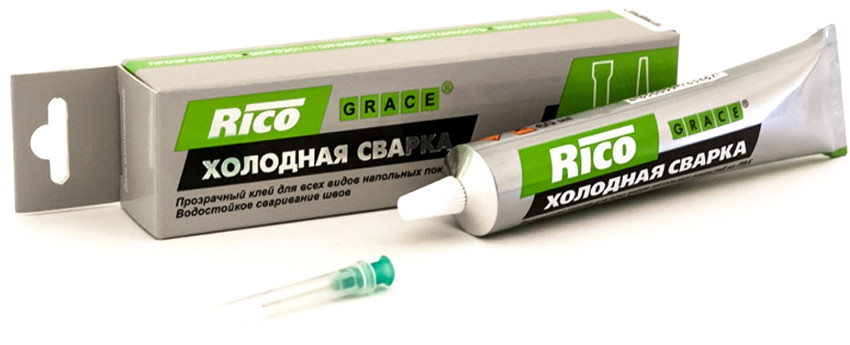
When choosing cold welding, you need to take into account all the characteristics of the materials that will be glued
In addition, the degree of stress that the joint can withstand (tensile and shear strength), as well as the rate of drying, are important.
Useful advice! For gluing plastic cases and thin parts, it is better to use a liquid compound. Rough jobs, such as joining sewer and heating elements, aligning bumpers or fixing storm drains, require a more secure fit. For these purposes, it is recommended to use a welding that has a consistency like that of plasticine.
Which cold welding is best for aluminum: tips for choosing a composition
A compound for welding aluminum is sold in the form of a liquid two-component glue or mastic. Epoxy resin is used as a base. In addition, additives and special fillers are included in the composition, thereby increasing the strength, resistance of the compound to high temperatures and aggressive substances. These components also improve the adhesion properties of the weld. This glue will be very useful if repairs are required in difficult conditions.
Related article:
Linoleum: photos of coatings in various rooms and tips for choosing a material
Advantages, disadvantages, characteristics and properties of various classes and types. Recommendations for the choice of material.
There is a huge assortment in hardware stores means for gluing aluminum, both domestic and foreign production.In order not to be mistaken with the choice, you need:
- make sure that the characteristics of the glue correspond to the requirements of the types of work that will be performed with it;
- give preference to universal options designed for gluing aluminum with other types of materials;
- carefully study the manufacturer's recommendations along with the instructions;
- consult with the seller;
- to get acquainted with the customer reviews left on cold welding.
In addition, one should take into account the fact that it takes much longer for liquid formulations to dry than for mastic.
How to use cold welding when laying linoleum
The process of bonding the coating is quite simple. Even a beginner can handle this work, the main thing is to fully comply with the technology and act carefully. Before gluing the joints of linoleum, you need to make sure that all the necessary tools and devices are at hand.
In addition to glue, you will need to work:
- Ruler and square - it is advisable to use metal models for these purposes. Products made from such material do not deform. Moreover, they are very thin and even. The ruler must be long.
- Masking tape - Alternatively, if not available, you can use the double-sided option.
- Cutting tool - the blade of the knife must be sharp so that all cuts are as accurate as possible.
- Protective underlay - Placed under the seam to prevent damage to the floor during the cutting process. For these purposes, plywood, thick cardboard, chipboard or a piece of old linoleum can be used.
- Protective equipment - mask or respirator for respiratory protection, and gloves.
Useful advice! When buying linoleum, you need to take material with a margin, since for alignment and high-quality joining of the canvases, you will additionally need about 6 cm.
How to cut linoleum at home and how to do it right
Several tool options can be used to cut natural linoleum and PVC flooring.
The construction knife is a tool with a retractable design with a replaceable cutting blade that is rigidly fixed. Outwardly it looks like a clerical knife, but it is adapted for construction needs. It is used for cutting thin and thick materials. In the process of work, it is imperative to control the course of its blade.
A linoleum knife is a tool with a curved cutting element, in some models it has the shape of a hook. Suitable not only for cutting linoleum, but also for cutting carpets and other soft surfaces. It is convenient to make straight and curly cuts with this knife.
The floor cutter has many modifications. The version, which is adapted for linoleum, is equipped with a disc-shaped cutting element that is fixed on a special frame with a handle. With it, you can make high-quality cuts with a smooth edge.
The adhesion strength of the canvases depends on how smoothly the cuts are made. Before gluing linoleum with cold welding, you need to carefully and accurately cut the material. Before starting work, the coating is kept indoors for 1-2 weeks. The exact date is indicated by the linoleum manufacturer. This is necessary in order for the material to adapt to the temperature regime of the room.
In order not to be mistaken in the process of cutting linoleum, it is advisable to take measurements several times. Based on this data, a calculation is made. Having drawn up a scheme for placing canvases, you can greatly facilitate your work.
Cutting allowances:
| Room length, m | Allowance size, mm |
| 5-6 | 20 |
| 6-10 | 40-50 |
| 10-12 | 50-70 |
The allowances compensate for the natural shrinkage of the material, as well as losses during the trimming process. Cutting linoleum must be done with confident movements, making pressure. After that, the canvases are kept indoors for 3 to 5 days until they straighten.
Important! Do not try to remove the “waves” from the surface in any way. If the material is of good quality, it will straighten itself.
Then the canvases are laid out around the room and in places where communications or decorative elements stick out, the excess is cut off. Before doing this, you need to prepare a pattern-pattern and transfer the markings to linoleum with it.
Laying linoleum: how to join sheets before soldering
Before soldering the linoleum, you need to make sure that its sheets are fixed correctly, and their edges are well joined. In this case, the adhesive can evenly fill the gap and form a strong bond.
The base is cleaned of debris and dust before gluing. If linoleum with a pattern is laid in the room, one canvas should be laid out on the floor, and the second should be placed on top of it with an overlap of approximately 5 cm. A protective substrate should be placed under the material first. It must be present along the entire length of the joint. The position of the segments in relation to each other changes until the pattern in the joint area coincides.
Then a marking is applied to the top sheet, indicating the place of the joint. It is desirable that this line runs through the center of the overlap. Now you can start removing excess material. This requires a long ruler, which must be placed along the future seam. It is imperative to make sure that both canvases are under it. With the help of a ruler, the canvas is well pressed, a cut is made along it. In order for the joint for welding linoleum to be smooth and neat, you need to cut two sheets at the same time.
Material fixation can be done in different ways. To achieve a reliable result, you need to cover the entire floor surface with glue. The second method involves fixing the material with double-sided adhesive tape. In this case, the canvases are not attached so rigidly. Most often, this method is used if linoleum will be used as a temporary coating. The glue for fixing the canvas to the floor is prepared according to the manufacturer's instructions, which is attached to the package. It is better to use a spatula to apply the composition.
There is a certain order of installation of the coating. First, the material is attached to the wall. Further, with wave-like movements, the glue is applied to 60-70% of linoleum. The amount of the composition must be controlled so that there is no surplus. Then the canvas must be carefully lowered and smoothed over the entire area. For this, its surface is rolled with a heavy roller. Similarly, the installation of the coating is carried out on the second half of the room.
Useful advice! If a tool such as a heavy roller is not at hand, a building level can be used instead. Beforehand, it should be wrapped with a soft cloth.
Consumption of glue for welding seams of linoleum and methods of its application
Before you glue the seams of linoleum, you need to evaluate the quality of its cutting and the shape of the edge. If the joints are uneven, it is advisable to use a product with a high content of PVC. Such sections usually diverge easily, and with the help of a thick composition, all voids can be filled qualitatively and material shift can be prevented. Adhesive with a large amount of PVC is ideal for joining fabrics with a complex angular shape.
If cold welding will be used to glue old linoleum that has been in use for a long time, it is better to take a viscous consistency for work.Such products contain a small amount of solvent, while they provide a high quality connection. Liquid formulations are suitable for gluing a new coating. After them, the seam is very neat and almost invisible, but the reliability of the connection is much lower.
There are two ways to apply linoleum welding glue:
- Both sections are thoroughly lubricated with a tube and needle. Under the influence of glue, the edges are fused and firmly connected to each other.
- First, only one edge is smeared and applied to the floor. Then, with the help of glue, the second cut is processed and fits tightly next to it. After that, the seam must be smoothed out.
The consumption of the composition depends on the qualifications of the person who glues, the thickness of the linoleum, as well as the characteristics of the product itself. In most cases, a type A solution is used. On average, a 50-60 mm tube can cover 25 running meters. m seam. Glue grade C is more viscous, so its consumption is higher. For processing 25 rm. m of the seam will require at least 70-90 ml. Some manufacturers indicate the amount of glue in grams. This nuance must be taken into account when calculating the required amount.
The consumption of glue of popular brands is shown in the table:
| Name of glue | Tank volume | Covered seam length, linear m |
| Axton | 60 g | 5 |
| WernerMuller | 44 g | 25 |
| Homacol S 401 | 60 ml | 25 |
| Rico | 60 ml | 25 |
| Second | 75 ml | 50 |
| Tytan | 100 ml | 45 |
| Sintex | 100 ml | 50 |
How to use cold welding for linoleum
When the cuts and joints of the material are adjusted, you need to make sure that there are no bubbles left under the surface of the canvases. During the welding process, air can move into the joint area and eventually destroy the seam. The webs should be pressed down with a small press. Before starting work, it does not hurt to study the manufacturer's instructions, which indicate how to properly glue linoleum and at what temperature it is recommended to use the glue.
Useful advice! Many adhesive masses contain aggressive components that can damage linoleum. This is especially true for coatings with a glossy sheen. To prevent the compound from getting on the front surface, the material is glued along the entire length of the joint with masking tape. This must be done so that only a few millimeters of the edging remain for the glue to interact. The tape is glued to both edges.
Using a special knife, you need to cut a groove between the sheets. In this case, you need to act very carefully so as not to damage the material on the sides.
The welding glue comes with a special nozzle in the form of a needle. You need to put it on a tube, after which you can start working. The groove between the sheets should be filled with glue until the composition appears above the surface of the adhesive tape by about 3-4 mm. Then the needle must be consistently advanced along the entire length of the joint, applying the product in the same way. After filling the joints, the glue must be left to dry for 15 minutes. During this time, the composition will set a little, after which it will be possible to remove the adhesive tape from the surface. It takes about 3 hours for the glue to dry completely.
It is not recommended to use a hair dryer or other methods of exposure to speed up drying. Under the influence of temperature, the composition can sharply decrease in volume, which will negatively affect the quality of the resulting compound. After the cold seal is completely dry, you can remove the excess adhesive. It is better to do this in two passes. First, strongly protruding areas are cut off, and after a day you can remove the remnants and carefully clean the surface. It will also not hurt to walk along the seam with felt.
If the composition does get to the surface, do not wipe it off immediately so as not to deform the seam and damage the coating. It is best to wait until the glue is completely dry and then cut it off with a sharp utility knife.
In general, any person can master the technology of cold linoleum welding. This process is quite simple and does not require much experience. The main thing is to observe safety precautions and act very carefully.

